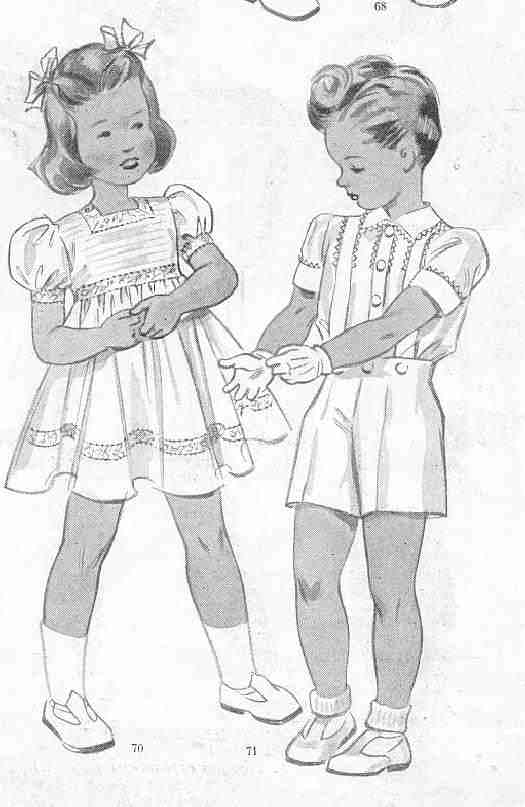
French Sewing Patterns: Fancy Outfits -- June 1941

Figure 1.--"Modes et travaux" in its June 1941 issue offered these patterns for fancy outfits for a little girl and boy. The boy's pattern was for a 4-year old. Note the button-on styling, and the puffed sleaved and ruffled collar blouse. The girl's pattern was for a 5-year old. Notice the boy, but not the girl, wears white gloves. Click on the image for a back view of the various outfits.
|
Modes et travaux in its June 1941 issue offered patterns for several Spring outfits for younger boys and girls. The age for each garment is not specified, but they appear to be for children 4-6 years of age. Most of the outfits wre dresses for girls, but there was one fancy Spring outfit for boys.
Modes et travaux
Modes et travaux was perhaps the most important French sewing magazine in the 1940s. During the German occupation after 1941, clothing became increasingly difficult to obtain. Thus sewing your own or your family's clothing became increasingly important. The title reads, "jours de fête". That would translate as "party days" or perhaps a less literal translation would be, "lets party!". A French reader points out that "lets party!" would be more proerly translated as "faisons la fête". The author then goes on to describe six different outfits for boys and girls. The fancy outfit for a little boy described here is the only boys' outfit.
Fancy Outfits
Modes et travaux in its June 1941 issue offered pattern for the fancy button-on outfit seen here. The boy's pattern was for a 4-year old. Note the button-on styling, and the puffed sleaved and ruffled collar blouse. The girl's pattern was for a 5-year old. Notice the boy, but not the girl, wears white gloves.
Ad Copy
The ad copy for the fancy outfit shown here reads, "71: Ce petit garçon porte un une culotte en shantung ou en flanelle blanche, la blouse est en toile de soie garnie de croquet, la culotte se boutonne sur la blouse. Métrages pour 4 ans: 0 m. 40 en 1 mètre poir la culotte et 0 m. 75 en 0 m. 80 pour la blouse." That would translate as "This little boy wears short pants in Shantung silk or white flannel, the blouse is in silk fabric furnished with [?croquet], the shorts button on to the blouse. Measurements for a 4 year old: 0 Mr. 40 in 1 meter for the shorts and 0 Mr. 75 in 0 Mr. 80 for the blouse."
Notice the boy's fancy hair style in the drawing. This was not just the illustrator's imagination. French boys have not worn curls as commonly as boys in seberal other countries, including America. HBC has noted, however, one curled hair style. A French reader describes a "coiffure de garçonnet avec une choupette". He reports that it was was common from the 1930s and early 50s with mothers who wanted to make a younger boy look nice and he himself wore such hair styles. He indicates that choupette was a familiar name. It consist as a big curl of hair placed in the the middle of the head. The vogue was quite common for boys in affluent families and to make boys look alike "enfants modèles" (model children).
Christopher Wagner

Navigate the Boys' Historical Clothing catalog/magazine pages:
[Return to the Main French 1941 catalog page]
[Main photo/publishing page]
[Store catalogs]
[Fashion magazines]
Navigate the Boys' Historical Clothing Web Site:
[Introduction]
[Activities]
[Bibliographies]
[Biographies]
[Chronology]
[Clothing styles]
[Countries]
[Contributions]
[FAQs]
[French glossary]
[Satellite sites]
[Boys' Clothing Home]
Navigate the Boys' Historical Clothing Web Site:
[Blouse]
[Buster Brown suits]
[Button-on suits]
[Pinafores]
[Capes]
[Pinafores]
[Ring bearers]
[Rompers]
[Ruffled collar]
[Sailor suits]
[Sailor hats]
[Smocks]
[Tunics]
Created: December 5, 2001
Last updated: December 5, 2001



